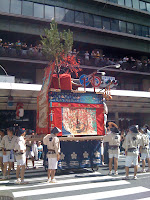





We are lucky to be in Kyoto for the annual Gion Festival, which goes on for a couple of weeks in July. We took on crowds, heat, and the occasional rainstorm to participate for at least a couple of events. The Gion Festival, an annual event dating back to 869, is dedicated to the deity of the Yasaka Shrine (see Shrines posting). It began as an effort to appease the deity and stop a series of devastating plagues. In 970 it became an annual event and, except for some brief interruptions, has occurred every year since. Although the festival began as a religious ritual, by the 12th century, it had developed into a way for the wealthy Kyotoites to show off their wealth. By the 15th century, when the Kyoto kimono merchants had become fabulously wealthy, they began a fierce competition over who could build the biggest and most elaborate floats. The floats are decorated with tapestries and fabrics, mainly from Nishijin, Kyoto's famous textile district, although some were imported in the 15th century from India, Belgium, Persia, Turkey and other countries via the Silk Road. Now, the Festival is largely a social event--not unlike Mardi Gras, the float parade an excuse for a week-long street party.


On Friday, we walked around an 8-square block area of downtown where the floats were on display with explanations of the stories they depicted. We have been here long enough to have begun to recognize some of them--one about a battle on a bridge in Uji--we crossed the very bridge and read about the same story there... Kyotoites and other Japanese


tourists dress up in traditional garb; beer and sake flow freely.


On Saturday, we got up early and biked over to Shijo-dori, where the parade was to begin. At 8 am, crowds had already gathered; nonetheless, I managed to get a front row position (the Japanese are so NICE!).
There are two kinds of floats: yama and hoko. The yama are the smaller floats (pictured first here), which depict scenes from Chinese and Japanese history and are topped with pine trees, shrines, and mannequins. They weigh about 1.5 tons and are "carried" by men on their shoulders (there are small rubber wheels underneath). All ages of men participate in the parade--just men as far as I could tell although on Friday, there were plenty of women in the booths near each float selling souvenirs--I'm guessing to help finance the floats.
The older men (and I do mean older in some instances) parade in front of the floats; the younger ones do the grunt work of lifting and pulling. Even little boys parade, although some of them had a look of "anywhere but here!" on their faces during the parade (it was Hot!). You get the sense that several generations of the same families work together on the floats, some of which actually have been passed down through the centuries--they're referred to as "floating museums." This yama with a grasshopper on top that occasionally flapped its wings was a crowd favorite.
The larger floats are the hoko, massive 2-storied affairs that are pulled on huge wheels. The second story may have musicians jangling bells as the float works its way along. Some of the larger floats require up to fifty men to pull it through the streets (and those big wooden wheels are the real wheels-a bump in the road and the whole float wobbles). The men on top hold ropes attached to the giant poles in case a wobble gains momentum.
 Bill here: actually, watching any given float was astonishing in terms of size (fifty men were pulling giant ropes to move these things along), organization (two men walked backwards pulling blocks of wood that could be instantly inserted under the wooden wheels as brakes!), and beauty (some of the tapestries were gorgeous). But, suddenly everything would stop for five or ten minutes. I realized how important those high school bands can be, or those clowns, or even those guys in red hats on those little scooters. Movement! After an hour we walked along the sidewalk back towards the starting point and managed to see all the floats. Our own little festival in reverse. And, by the way, the grasshopper was way cool. Movement!
Bill here: actually, watching any given float was astonishing in terms of size (fifty men were pulling giant ropes to move these things along), organization (two men walked backwards pulling blocks of wood that could be instantly inserted under the wooden wheels as brakes!), and beauty (some of the tapestries were gorgeous). But, suddenly everything would stop for five or ten minutes. I realized how important those high school bands can be, or those clowns, or even those guys in red hats on those little scooters. Movement! After an hour we walked along the sidewalk back towards the starting point and managed to see all the floats. Our own little festival in reverse. And, by the way, the grasshopper was way cool. Movement!Terry again--yes, that's Giorgio Armani you're seeing behind the floats. That's the real beauty, and joy, of Japan, especially Kyoto. All that centuries-old tradition, lovingly honored and repeated, juxtaposed with the astonishingly new and hip.






No comments:
Post a Comment